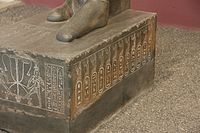Egyptian statue of Darius I
| Egyptian statue of Darius I | |
|---|---|
Teheran) | |
| Material | Grey granite from the Wadi Hammamat, eastern Egypt |
| Size | 2.46 m high |
| Created | 6-5th century BCE |
| Discovered | Susa (Iran), in 1972 |
| Present location | National Museum of Iran (Tehran) |
The Egyptian statue of Darius I is a statue of Achaemenid ruler
Darius I with Egyptian iconography and inscriptions. This is the best known example of in-the-round statuary that has remained from the Achaemenid period.[1]
Darius I is depicted wearing a Persian dress, and armed with a dagger at his belt. The pleats of the right side of the robe are inscribed in Old Persian, Elamite and Babylonian
hieroglyphs. According to these inscriptions, the statue was made in Egypt at the request of Darius. This would have followed the Achaemenid conquest of Egypt.[1]
The base of the statue is in Egyptian style. The front and back has a depiction of
Nile. The sides represent rows of vassals from numerous countries, with a total of twenty-four cartouches.[1][3]
The statue was made in Egypt from grey granite, but was then transported to Susa, possibly by Xerxes I.[1]
The statue is of grey granite that chemical analysis has indicated comes from the Wadi Hammamat in eastern Egypt. It was made in Egypt and later brought to Susa possibly in the reign of Xerxes.[1]
Details
-
Detail of the base.
-
List of subject countries on the base of the statue.
References
Wikimedia Commons has media related to Statue of Darius I.
- ^ a b c d e f Razmjou, Shahrokh (1954). Ars orientalis; the arts of Islam and the East. Freer Gallery of Art. pp. 81–101.
- ISBN 978-0-500-20428-3.
- ^ ISBN 978-1-78570-306-5.



![Territories of India, Sattagydia and Arachosia on the statue.[3]](http://upload.wikimedia.org/wikipedia/commons/thumb/b/ba/India_Sattagydia_Gandhara_on_the_Statue_of_Darius_I.jpg/200px-India_Sattagydia_Gandhara_on_the_Statue_of_Darius_I.jpg)